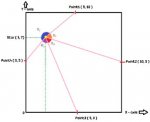Hi guys,
I am seeking help for my project. I am kind of stuck here.
I am given 4 base station and a point on the Cartesian plane. How do I find the angles Θ1, Θ2, Θ3 & Θ4. Can someone advice me on how i can calculate them?
View attachment 2734
I really appreciate if someone could help me. Thanks
I am seeking help for my project. I am kind of stuck here.
I am given 4 base station and a point on the Cartesian plane. How do I find the angles Θ1, Θ2, Θ3 & Θ4. Can someone advice me on how i can calculate them?
View attachment 2734
I really appreciate if someone could help me. Thanks

